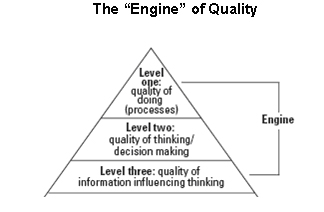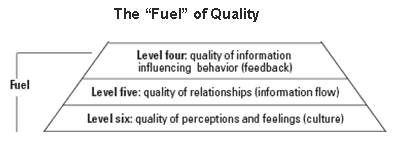Organizational change would be so easy if it weren’t for all the people.
“I suffer simultaneously from amnesia and déjà vu. I have the feeling that I keep forgetting the same thing over and over again.”—Steven Wright (surreal comedian)
It all seems so logical, doesn’t it? Focus on processes, improve your organizational decision making through utilizing quality improvement tools, give people good technical and administrative information, and the organization “should” get better. It’s so tempting, interesting, and dramatic to lead in the vein of “Star Trek: The Next Generation” with Capt. Jean Luc Picard’s: “Make it so.”
However, in more than 25 years of facilitating quality improvement, I have learned two things:
1. Change would be so easy if it weren’t for all the people.
2. Logic + Humans = Change? Think again!
The learning organization is here to stay. Yet adult learners are a particularly ornery breed, and it is delusional to expect that intensive in-house seminars will somehow allow participants to attain anything even close to mastery when comfortable old habits are threatened. Not only that, but there is a naïve assumption that they will subsequently choose to act on the knowledge—when going back to jobs that they perceive to take more than 100 percent of their time. So, we need to keep in mind some timeless classic wisdom from more than 70 years ago that is just as applicable today:
“When we are dealing with people, let us remember we are not dealing with creatures of logic. We are dealing with creatures of emotion, creatures bustling with prejudices and motivated by pride and vanity.”
—Dale Carnegie, personal effectiveness pioneer and author
Leadership mantras and wisdom
Recently I encountered this wonderful leadership wisdom:
“It’s in the interval between stimulus and response where the leader emerges.”
In other words, leaders emerge as a result of intense interior work that allows one to transcend ingrained, automatic past responses, enabling you to insulate your hot buttons.
Quality improvement people need to transform to change agents and cultivate this interval to leverage it to full advantage. So, I will begin by giving you two mantras I have shared with many audiences to help them calm down and redouble their efforts to overcome, as you will see, “disgustingly predictable” (said tongue-in-cheek) resistance to any change.
Leadership Mantra No. 1: “Given—people don’t really object to change; they just hate being changed themselves.”
When you are explaining the reason for a needed change and people respond in anger and tell you why they can’t do it, tell you why it applies to everyone else but them, or ask you to explain it once more (again, for the 20th time) and you want to throttle them, take a deep breath and say to yourself, with a smile in your heart, “Those darn humans. God bless ‘em. They are acting just like people.”
Now, a further challenge: They have the luxury of acting like people. You do not. After you calm yourself down, you have to ask yourself the second mantra:
Leadership Mantra No. 2. “How do I change to get them to want to volunteer to change?”
Peter Block, a management consultant for whom I have a lot of respect, says it so well: “Most human problems are permanent.”
To which I say: “Given!” So where do we go from here?
Time to go beyond “logic”
The main result of the flurry of organizational quality training efforts the last 20 years has been creating awareness of some of the concepts from a quality improvement model as shown in figure 1. The model was originally suggested by John R. Grinnell. Seen as a pyramid, the first three levels consist of:
Level one: Quality of doing. The processes employees use to do their jobs, directly yielding an organization’s results.
Key: Context of process-oriented thinking
Level two: Quality of thinking and decision making. The decisions that support the doing.
Key: Statistical thinking and quality tools
Level three: Quality of information. The information that influences employees’ thinking.
Key: High quality technical and administrative information
 Most training and education ends here. No one puts the very necessary culture change that this mandates on the to-do list. The prevailing belief is that logic will prevail. So, ultimately, results have been disappointing.
Most training and education ends here. No one puts the very necessary culture change that this mandates on the to-do list. The prevailing belief is that logic will prevail. So, ultimately, results have been disappointing.
Refining thinking skills through many of the traditional quality tools and frameworks such as Six Sigma and lean should sharpen decision-making capability. However, as a history of failed programs has shown, focusing just on the tools and utilizing them through, generally, projects not directly related to deeper organizational strategic issues is not enough.
All these efforts give cursory attention to the most nontrivial task of creating and attaining the significant cultural behavior changes—at many levels—required for true success.
“Engines” Need “Fuel”
Although these provide a great engine for quality improvement, engines need fuel, and as seen in figure 2, the pyramid widens to include:
Level four: Quality of information. The information that influences employees’ behavior (personal feedback processes).
Level five: Quality of relationships. The relationships through which this information flows.
Level six: Quality of perceptions and feelings. The emotions that influence employees’ relationships with others—including co-workers, personnel from other departments, and management (organizational culture).
But, ultimately, the base of the pyramid (and its interaction with level six) is the bottleneck.
Level seven: Quality of individual mind-sets. The personal operating beliefs and values—and resulting emotional baggage—every employee brings to work processes, which are shaped by the unique experiences of each individual’s first 20 years of life.

In most organizational environments, people have neither been trained to give feedback appropriately nor manage their ego’s reactions to feedback in necessarily healthy ways. Like it or not, fear and defensiveness tend to be the rule within most organizations, and longstanding cultural patterns are ingrained. Emotional blockages due to bad relationships will determine the amount, quality, and timeliness of information flow between people.
Every good book on quality improvement makes a key point that being successful in transforming an organizational culture will require feedback—and lots of it—both up and down the organization. In my opinion, Thomas Crane’s book, The Heart of Coaching: How to Use Transformational Coaching to Create a High-Performance Coaching Culture, Third Edition (FTA Press, 2007 ) is one of the absolute best in an overall context of improvement. There is a free download of the first three chapters available on his web site (www.craneconsulting.com).
In fact, in the best-led cultures, leaders will actually aggressively seek honest feedback on their performance, realizing that feedback is a perception being shared and not a truth being declared. The culture’s perception is the leadership’s reality and it allows leaders to ask themselves these important questions in response:
1. Is that a perception I would like the culture to have?
2. If that perception continues, will the organization be able to attain its desired results?
3. If the answers to questions No. 1 and No. 2 are “no,” how do I have to change to create a different perception?
This leads to the third mantra:
Leadership Mantra No. 3: “As a leader, I must learn to swallow my ego 10 times before breakfast and another dozen times before lunch.”
There needs to be an organizational commitment to depersonalizing issues and creating a culture where feedback can flourish (and the answer is not willy-nilly implementation of “360° feedback.” That’s a whole other article.). Immediate expectations of both “blaming processes, not people” and zero tolerance for blame as a cultural norm will maybe catalyze a much-needed quantum leap in cultural morale that will allow this to happen.


